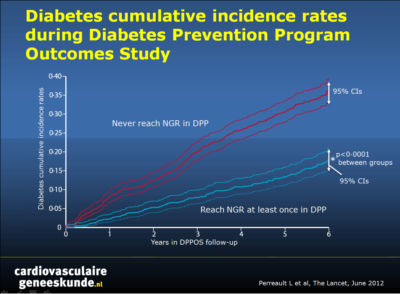Normale glucose regulatie in prediabetes geassocieerd met verminderd risico op ziekteprogressie
Literatuur - Perreault L et al; Lancet June 9 2012Effect of regression from prediabetes to normal glucose regulation on long-term reduction in diabetes risk: results from the Diabetes Prevention Program Outcomes Study
Leigh Perreault, Qing Pan, Kieren J Mather, et al, for the Diabetes Prevention Program Research Group
Lancet 2012 (published online before print) DOI:10.1016/S0140-6736(12)60525-X
Achtergrond
Prediabetes is een verzamelnaam voor verminderde nuchtere glucose of een verminderde glucosetolerantie (of beide). Screening op prediabetes is aan te raden, want het is een belangrijke risicofactor voor het ontstaan van diabetes type 2 in de toekomst en kan leiden tot diabetische complicaties [1-4]. Preventie van diabetes en de complicaties ervan kan leiden tot de omkering van prediabetes en het herstel van een normale glucoseregulatie.Het Diabetes Prevention Program (DPP) onderzocht voorspellers voor het herstel van normale glucoseregulatie [5]. Na afloop werd de Diabetes Prevention Program Outcomes Study (DPPOS) gestart, waardoor de mogelijkheid ontstond om het voortduren van de voorspellers van normale glucoseregulatie (aan de behandeling gerelateerde of anderszins) vast te stellen en de lange-termijn risicoreductie voor diabetes te kwantificeren in deelnemers die een normale glucoseregulatie bereikten. De hypothese was dat het bereiken van normale glucoseregulatie het risico op diabetes aanzienlijk en duurzaam kon verminderen ten opzichte van de deelnemers met aanhoudende prediabetes.
In deze analyse werden 1990 deelnemers van DPPOS geïncludeerd.
Belangrijkste resultaten
- Deelnemers die een normale glucoseregulatie bereikten ten minste een keer tijdens de DPP hadden een 56% minder risico op progressie naar diabetes gedurende DPPOS (HR 0.44, 95% CI 0.37-0.55, p <0,0001); risicoreductie werd sterk geassocieerd met het aantal maal dat normale glucoseregulatie werd bereikt
- Risicoreductie werd niet beïnvloed door eerdere groepsindeling
- Factoren geassocieerd met een verhoogd risico op diabetes waren omgekeerd evenredig aan de kans dat een patiënt een normale glucoseregulatie bereikte. In het verleden bereiken van normale glucoseregulatie (OR = 3,18, 95% CI, 2.71 tot 3.72), de gevoeligheid voor insuline (OR = 3,18, 95% CI, 2.71-3,72) en verhoogde bèta-cel functie (OR = 1,28; 95% CI, 1.18-1.39) werden in verband gebracht met een normale glucoseregulatie.
Redactioneel commentaar [6]
De resultaten suggereren dat regressie van slechte glucosetolerantie naar normoglycemie ofwel spontaan is of in respons op de behandeling. Factoren die regressie voorspellen naar normoglycemie, wat deze regressie tijdelijk of duurzaam maakt, en of regressie de lange termijn resultaten vermindert zijn allemaal vragen die nader onderzocht moeten worden. De resultaten van dergelijk onderzoek kunnen de therapeutische strategie van preventie van diabetes en een levenslang glucoseverlagende behandeling veranderen naar de inductie van regressie en toezicht op terugval tijdens therapie.
Referenties
1. Diabetes Prevention Program Research Group. The prevalence of retinopathy in impaired glucose tolerance and recent-onset diabetes in the Diabetes Prevention Program. Diabet Med 2007;24:137–44.2. Cheng YJ, Gregg EW, Geiss LS, et al. Association of A1C and fasting plasma glucose levels with diabetic retinopathy prevalence in the U.S. population: implications for diabetes diagnostic thresholds. Diabetes Care 2009;32:2027–32.
3. Ford ES, Zhao G, Li C. Pre-diabetes and the risk for cardiovascular disease: a systematic review of the evidence. J Am Coll Cardiol 2010;55:1310–17.
4. Ziegler D, Rathmann W, Dickhaus T, Meisinger C, Mielck A. Prevalence of polyneuropathy in pre-diabetes and diabetes is associated with abdominal obesity and macroangiopathy: the MONICA/KORA Augsburg Surveys S2 and S3. Diabetes Care 2008;31:464–69.
5. Perreault L, Kahn SE, Christophi CA, Knowler WC, Hamman RF. Regression from pre-diabetes to normal glucose regulation in the Diabetes Prevention Program. Diabetes Care 2009;32:1583–88.
6. Yakubovich N, erstein HG. Is regression to normoglycaemia clinically important? Lancet 2012 (published online before print) DOI:10.1016/S0140-6736(12)60828-9
Abstract
Background:Our objective was to quantify and predict diabetes risk reduction during the Diabetes Prevention Program Outcomes Study (DPPOS) in participants who returned to normal glucose regulation at least once during the Diabetes Prevention Program (DPP) compared with those who consistently met criteria for prediabetes.
Methods:
DPPOS is an ongoing observational study of participants from the DPP randomised trial. For this analysis, diabetes cumulative incidence in DPPOS was calculated for participants with normal glucose regulation or prediabetes status during DPP with and without stratification by previous randomised treatment group. Cox proportional hazards modelling and generalised linear mixed models were used to quantify the effect of previous (DPP) glycaemic status on risk of later (DPPOS) diabetes and normal glucose regulation status, respectively, per SD in change. Included in this analysis were 1990 participants of DPPOS who had been randomly assigned to treatment groups during DPP (736 intensive lifestyle intervention, 647 metformin, 607 placebo).
Findings:
Diabetes risk during DPPOS was 56% lower for participants who had returned to normal glucose regulation versus those who consistently had prediabetes (hazard ratio [HR] 0•44, 95% CI 0•37—0•55, p<0•0001) and was unaffected by previous group assignment (interaction test for normal glucose regulation and lifestyle intervention, p=0•1722; normal glucose regulation and metformin, p=0•3304). Many, but not all, of the variables that increased diabetes risk were inversely associated with the chance of a participant reaching normal glucose regulation status in DPPOS. Specifically, previous achievement of normal glucose regulation (odds ratio [OR] 3•18, 95% CI 2•71—3•72, p<0•0001), increased β-cell function (OR 1•28; 95% CI 1•18—1•39, p<0•0001), and insulin sensitivity (OR 1•16, 95% CI 1•08—1•25, p<0•0001) were associated with normal glucose regulation in DPPOS, whereas the opposite was true for prediction of diabetes, with increased β-cell function (HR 0•80, 95% CI 0•71—0•89, p<0•0001) and insulin sensitivity (HR 0•83, 95% CI 0•74—0•94, p=0•0001) having a protective effect. Among participants who did not return to normal glucose regulation in DPP, those assigned to the intensive lifestyle intervention had a higher diabetes risk (HR 1•31, 95% CI 1•03—1•68, p=0•0304) and lower chance of normal glucose regulation (OR 0•59, 95% CI 0•42—0•82, p=0•0014) than did the placebo group in DPPOS.
Interpretation:
We conclude that prediabetes is a high-risk state for diabetes, especially in patients who remain with prediabetes despite intensive lifestyle intervention. Reversion to normal glucose regulation, even if transient, is associated with a significantly reduced risk of future diabetes independent of previous treatment group.


Deel deze pagina met collega's en vrienden: